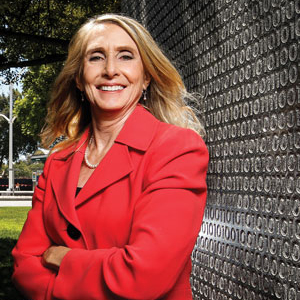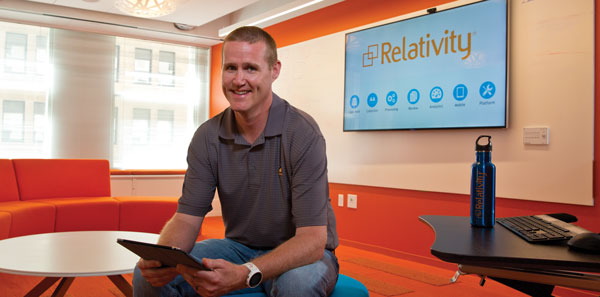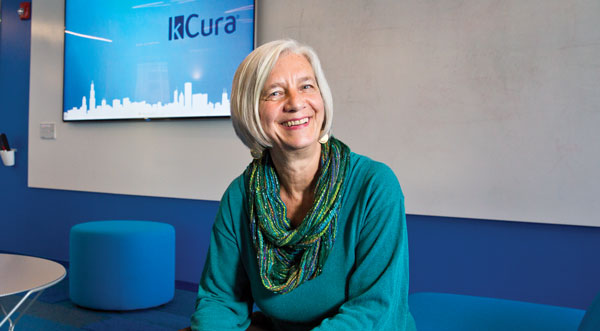What the jobs are: New tech and client needs create a new field of legal operations

Connie Brenton, chief of staff and director of legal operations at NetApp. Photograph by Tony Avelar.
Yes, that’s right, digital transaction management. DTM. You know what that is, right?
Let me begin this story with a confession. I am a law professor. I am reputed to be an expert on the legal services industry. Until the morning of the conference, I had never heard of DocuSign, which is 33rd on the Wall Street Journal’s Billion Dollar Startup Club for September. I was also ignorant of DTM.
But that is OK because this story is about the milewide gulf between the legal profession’s infinitesimal knowledge of the burgeoning field of legal operations (of which DTM is a tiny part) and how that field is going to reshape the entire industry. Before getting into definitions and explanations, however, let’s get a clear example onto the table.
I am getting schooled this morning by Connie Brenton, chief of staff and senior director of legal operations at NetApp, a $6 billion-a-year B2B company that specializes in data management and storage systems. Brenton is presenting a case study on the benefits of electronic signature, the most common application of DTM.
NetApp started using electronic signature in 2012 with its nondisclosure agreements. Electronic signature eliminates the need for scanning originals, getting ink signatures, warehousing paper documents, and coping with lost or deleted copies via email. The system also generates useful analytics to improve the process.
The rollout was a huge success, so electronic signature was gradually expanded to 26 other areas, involving finance, information technology, human resources, product management, marketing, sales, customer billing and professional services contracting. We are shown before and after process maps, often with the legal department engineered out of routine business matters. People can get their work done faster, which they like.
As a legal operations professional, Brenton forces upon herself the discipline of measuring the return on investment of her change initiatives. Since 2012, electronic signature has reduced the workload on the NetApp legal department by 75,000 hours, a total equivalent to an attorney working 2,000 hours a year for 37½ years. Yet electronic signature is only one of dozens of projects that Brenton is running.
Editor’s Note: Starting in 2011, the ABA Journal initiated a series of reports on the shifting paradigm of law practice. This series looks at how the legal business is responding—and the legal profession often not responding—to pressures never before placed on lawyers and law firms: a maturing market, disruptive technology, economic recession and the rise of legal services competition.
In this article, Indiana University law professor William Henderson, who helped create the Paradigm Shift series, discusses new jobs for JDs providing a different kind of legal service in law firms, new businesses and in-house departments. These jobs blend technology and business skills with law into a field he calls legal operations. And in a profession showing little to no job growth for recent law school graduates, this field offers both steady income and new challenges to those who join it.
There is also online-only content for the series, available here.
Paradigm Shift Feature Stories
October 2015
What the jobs are: New tech, new client needs create a new field of legal operations
September 2015
Roundtable on change and challenge in the business of law
February 2015
Model program brings holistic solutions to divorce
January 2015
Does the UK know something we don’t about alternative business structures?
June 2015
Who owns the law? Technology reignites the war over just how public documents should be
May 2014
These venture capitalists skip law firms for legal services startups
October 2013
Who’s eating law firms’ lunch?
July 2012
The Pedigree Problem: Are law school ties choking the profession?
January 2012
The Law School Bubble: How long will it last if law grads can’t pay bills?
A NEW WORRY
The legal press frequently covers the travails of BigLaw, where partners worry that their highly profitable enterprises might go the way of Dewey & LeBoeuf, Heller Ehrman, Howrey—the list goes on.
What is not well-understood, however, is that a substantial part of this unease is traceable to people like Brenton. General counsel are increasingly giving senior “legal ops” professionals the authority to improve legal department performance, including the hiring and managing of outside counsel. When this happens, outside law firms have to justify how they are providing greater value than the dozens of other law firms and new law service providers that are dying to get in the door.
Over the last couple of years, I have picked up clues that legal operations is becoming a high-impact movement with several epicenters. One of the biggest is the Corporate Legal Operations Consortium, made up of several dozen legal ops professionals at Bay Area companies, including Adobe, Cisco, Google, NetApp, Oracle and Yahoo. There are similar organized groups in the Midwest and on the East Coast.
Yet as I have studied this issue, I have gradually concluded that legal operations is not just a job within a legal department. Legal operations is a multidisciplinary field where professionals collaborate to design and build systems to manage legal problems.
A lawyer might say to a client: “Better, faster and cheaper—pick two.” A legal operations professional figures out ways to get all three.
To date, the greatest advances in legal operations have occurred in legal departments, yet the same inventive methods and mindsets are cropping up in traditional law firms and sophisticated “New Law” companies funded by nonlawyer investors.
FILLING IN THE PUZZLE
Since 2008 I have spent a lot of time talking to lawyers. That year is significant because that’s when I got tenure at Indiana University, largely on the strength of my empirical work on law firms. My law review articles got a fair amount of attention from practicing lawyers. But frankly, I was not 100 percent certain that my analyses were correct.
My views on the legal market came largely from books, articles and fancy statistical models. I wanted to explain my theories to lawyers in language they could understand and have them criticize me. Then I could listen to them and revise my ideas until I was confident they were right. To implement my plan, I took every speaking engagement that was offered.
I was right about one thing: Some of my theories were wrong. In the fall of 2012 I made a presentation to a group of managing partners at a private gathering in Chicago. I presented data suggesting the New Law sector was eating into the market share of large establishment law firms. There was extensive banter on whether anything was being lost and, if so, whether it was worth keeping. I suggested in a fairly direct (some might say arrogant) way that the MPs and their fellow partners had blinders on.
Don Lents, then the chairman of Bryan Cave, broke the awkward silence: “How do you know whether some of us aren’t doing many of the things you have discussed, and perhaps more?”
I let the question sink in and then acknowledged the obvious. “I don’t know.”
As the legal market has entered a period of significant change, the problems of the old model are discussed ad nauseam at conferences and in the press. Potential solutions, however, are often kept under wraps as law firms and other organizations are reluctant to tip off the competition. Likewise, no one wants to draw attention to experiments that might fail.
This imbalance of information puts us at risk for what Nobel laureate Dan Kahneman calls the availability heuristic: We give heavier weight to readily available information and tend to discount, often to zero, alternative explanations based on information we have failed to gather and consider.
Since my encounter with Lents, I have tried to reduce the effect of the availability heuristic by building a large network within the legal industry and trying to ferret out what is new, different and better. Among law firms, several names crop up more than others; Bryan Cave is one. A chief business development officer at a large law firm, himself heavily networked in law firm and legal tech circles, has told me Bryan Cave was “miles ahead of everyone else.”
At the 2014 International Legal Technology Association conference, Bryan Cave walked away with a raft of awards, including the one for most innovative law firm. All the awards are attributable to one of three technology-enabled groups at the firm: the client technology group, the practice economics group and the accelerated review team. John Alber, the firm’s strategic technology partner at the time, ran all three.

Connie Brenton, chief of staff and director of legal operations at NetApp. Photograph by Tony Avelar.
A DETOUR AND AN OVERHAUL
When I get to St. Louis to interview Alber in April, he begins the conversation by telling me that he’s about to retire. “The kids are all grown. I am roughly retirement age. So we sold our house. After June, my wife and I will be living on a boat and traveling.”
Chronologically, Alber may be near retirement age (he is 64), yet he has the curiosity and wonderment of a 15-year-old at a science fair. His facial expression swings between smiles and deep thought.
Alber ended his legal career in the same place it began, albeit with one major detour. He joined Bryan Cave in 1981 after graduating from Southern Illinois University School of Law and a two-year clerkship on the Illinois Supreme Court. In 1988, shortly after becoming partner, Alber bought a niche publishing company. For decades, the company provided essential information to the transportation industry. As the digital age ramped up, Alber transitioned the company from publishing to database management to logistics before selling it in late 1998. He then returned to Bryan Cave.
I ask Alber: “After such an intense business career, what made you want to go back to practicing law?”
“Well, that’s not exactly what happened.” In the late 1990s, Alber explains, the firm’s IT system was in bad shape. The chairman, Walter Metcalfe Jr., asked Alber to return to preside over a large-scale overhaul. “The original assignment was supposed to last 18 months. After that I figured I would move on to my next business venture.”
During this process, however, Alber began collaborating with a Bryan Cave partner on a project that applied technology to the complexity of international trade law. According to Alber, it was basically an intricate set of decision trees embedded into computer code. Yet to the end user it was just a set of questions that could, once answered, provide quick, reliable guidance on trade. (Today these platforms are commonly called expert systems.)
“It was a challenging project, and I had no formal staff,” Alber recalls. “So I just started scavenging time and personnel from other units in the firm.
“We ended up offering it to the client for $120,000 per year all in. The client loved it, and right out of the box it was profitable for the firm.”
The partner Alber was collaborating with was Lents, who later became the firm’s chairman.
“After the trade regulation project, there was no shortage of challenging problems to solve,” Alber says. “It was like running a startup inside a major law firm, but with the downside risk removed. The firm let us experiment. It was the best of both worlds, so I stayed.”
A ‘PEG’ MORE
After the success of the trade regulation project, Chris Emerson, then a part of the firm’s IT group, became Alber’s full-time staffer. At the time, Emerson was in his mid-20s. Emerson is now director of Bryan Cave’s practice economic group—PEG as it’s known at the firm.
To build the infrastructure for what would later become PEG, Bryan Cave hired an accounting expert at Washington University to establish a state-of-the-art cost-accounting system for tracking and allocating costs. Alber, Emerson and other Bryan Cave staffers then translated the system’s principles and conventions into an IT platform that tracked the firm’s work in progress, collections and profitability.
As the IT system began piling up high-quality data, Alber and Emerson started mining it for patterns that would enable the firm to offer alternative-fee arrangements and make a reliable profit.
“We took one large tranche of matters and identified nearly 100 factors that could affect cost,” Alber explains. “Then, through statistical regression analysis, we discovered that approximately seven factors accounted for nearly all of the cost variability. That provided us with a very effective pricing model.”
Once the firm began moving to a flat-fee model, it also began to evaluate the best way to staff many of its matters. Today, roughly 15 percent of Bryan Cave’s attorneys work outside the traditional partner-associate model. A large proportion of them work on matters that have been priced by models supplied by PEG.
“On any given day,” Alber observes, “they are often the happiest lawyers in the building. They tend to work on teams and are encouraged to continuously improve the process. They get very good at their jobs.”
Christian Zust nods in agreement. And he would know, as he joined Bryan Cave as a contract attorney back in 2008 after receiving his JD/MBA from the University of Missouri in Columbia. “The market for entry-level associates was collapsing, so I was just happy to get my foot in the door.”
Zust eventually was assigned to the accelerated review team, where he thrived as an attorney. Yet Zust also proved to have the mind and skill set ideally suited for Alber’s data- and process-driven world. (Alber notes that Zust supplemented his income during law school by building statistical models that predicted point spreads more accurately than Las Vegas bookmakers.)
Zust eventually transferred from that team to PEG. When Alber left the firm, Zust stepped into the role of director of client technology, which involves both client interaction and supervision of nearly a dozen full-time software developers and programmers.
Zust readily acknowledges that he is on the ground floor of a new way of provisioning legal services. “I can see a path that is going to improve outcomes for both clients and lawyers. John tells us that he is worried that we are not experimenting enough with new methodologies. In law, that type of environment is rare.”
Rare but not unprecedented, as I had heard virtually those same words during my visit to NetApp. Brenton explained that experimentation and “willingness to fail” had become the signature philosophy of NetApp General Counsel Matt Fawcett. “That is the price of innovation. Matt gives us that net.”
At Alber’s farewell dinner in early June, Lents presented Alber with an official “Skunk Works” baseball cap.
Lents wanted to make the connection between Alber and the famous Lockheed Martin engineering team that accelerated development of fighter-jet technology during World War II. “John led our Skunk Works for 17 years,” Lents said.
A LEGAL TOOLMAKER
There is widespread consensus among lawyers and law schools that the legal job market is tight. But how do we define “legal”?
I ask this question as I review the jobs page for kCura, a 485-employee software company based in Chicago’s Loop. (The “k” stands for knowledge; “cura” means management in Latin.) Founded in 2001 as a small IT consulting firm, kCura attracted several significant law firm clients. Since 2007, it has been a pure software company that focuses exclusively on the legal industry. Its signature product is Relativity, a document management and workflow tool used for e-discovery and large-scale investigations.
Since 2008, when it employed 25 workers, kCura has been on a hiring spree. In June 2015, the company has 30 positions open, 29 in Chicago and one in Portland, Oregon. All are full-time professional jobs. Although kCura exists entirely within the legal ecosystem, the vast majority of the open positions are likely to sound unfamiliar to lawyers:
• API technical writer.
• Advice specialist.
• Big data architect-software engineering.
• Elasticsearch engineer.
• Product marketing specialist.
• QA software engineer.
• Sales operations specialist.
• Software engineer (Azure/Cloud).
• Strategic partnerships manager.
• User experience architect.
According to Chris Jenkins, kCura’s director of talent acquisition, the company will likely grow to 700-plus employees within three years.
Why is kCura growing so rapidly when its client base—traditional legal service providers—appears to be stuck in a pattern of flat or declining revenues and headcount? The firm is in a class of companies I refer to as toolmakers.
One of the hallmarks of a good legal tool is its ability to speed up or replace traditionally trained lawyers. For example, there are legal tools that create and refine machine learning algorithms for litigation document review (Recommind, Kroll, FTI) and corporate due diligence (Kira Diligence Engine). Likewise, dozens of companies offer technology to automate legal document assembly (HotDocs, ContractExpress). Other companies combine technology with expert domain knowledge so that clients can get self-service online legal solutions (Neota Logic, KM Standards), albeit these tools are often licensed to law firms who update the content and warrant the resulting legal advice. Several law firms are also making “client-facing” tools in-house with their own software engineers. The growth of kCura as a toolmaker is directly tied to the enormous business problem created by the burgeoning volume of electronically stored information. Andrew Sieja, kCura founder and CEO, notes that during the early days of Relativity (2008-10), the biggest case involved 17 million documents. Today the largest case involves nearly 205 million documents. The Relativity platform now has more than 46 billion files under management.

Chris Jenkins, Director of talent acquisition, kCura. Photograph by Wayne Slezak.
According to analysts at Gartner, an information technology research and advisory firm, kCura has moved into the top position in a crowded e-discovery software field of 20 competitors, including Hewlett-Packard, IBM, Microsoft and Symantec, with the highest combined score on “completeness of vision” and “ability to execute.”
Although there is considerable competition in the e-discovery software space, kCura appears to be thriving. Over the last two years, the privately held company has won numerous awards on measures related to entrepreneurship, innovation, growth and best places to work.
Earlier this year, kCura announced that it would take a $125 million minority investment from Iconiq Capital, a private equity firm based in San Francisco. According to Sieja, kCura will use the proceeds to “double down” on e-discovery software. This includes steady build-outs into the many areas that touch on the litigation process. Sieja describes his business as incremental rather than disruptive innovation. “We evolve with our customers,” he says.
A FACTORY OF PEOPLE
As I listen to Sieja describe his business, I struggle with a difficult line-drawing problem. Is kCura part of the legal industry?
I have shared the story of kCura’s success with several prominent law firm lawyers. The most common response is that kCura is “just a software company.” Yet it is growing rapidly because it is developing solutions to business problems created by litigation. Its core business is making lawyers more productive. This is also what Brenton is trying to accomplish at NetApp. And it is certainly the focus of three practice units created by Alber at Bryan Cave.
Traditional law firms are also trying to make lawyers more productive. Yet without the tools of data, process and technology, it is highly unlikely that they will set the standard. This is the fundamental truth driving the growth of legal operations.
In many respects, Sieja and his leadership team at kCura are responding to a similar productivity imperative that confronted the legal market nearly a century ago.
In the early 1900s, as industrial and financial companies grew into national and international enterprises, there was a shortage of sophisticated business lawyers who could handle the complexities of high finance and the rise of the administrative state. So leading law firms created the associate-partner model as a mechanism to hire and train law graduates who could help the firm keep up with demand. During the early 1930s, the Cravath Swaine & Moore law firm in Manhattan was described by the popular press as a “law factory,” yet a substantial amount of its output was highly trained lawyers. As such, the law factory was a place of youth and vitality.
The same is true at kCura. According to Chief People Officer Dorie Blesoff, millennials make up 60 percent of the company’s workforce. Blesoff, who holds a master of science degree in organizational development, was hired to build out an intensive professional development program. Back in 2008, Sieja read The Breakthrough Company by Keith McFarland. The goal of the book was to isolate common themes among the tiny fraction of U.S. companies that successfully scaled themselves into $250 million annual-revenue businesses. One theme was a human capital model that heavily invested in employee training and development.
Under Blesoff, the company has become a feedback-rich environment where each month has a specific professional development activity. The 2015 schedule is laid out in a small circle diagram distributed to every kCura employee: work goals in January, performance coaching in February, formal reviews in March. The cycle of coaching, feedback and goal-setting continues through December.

Dorie Blesoff, Chief people officer, kCura. Photograph by Wayne Slezak.
The human capital model is centered around kCura’s seven core values. Although presented as a system of values, they are defined through specific behaviors. For example, it’s a core value to “hold yourself and your colleagues accountable.” To be consistent with that value, employees are told to “be dependable, conscientious and empathic. Focus on self-improvement and know your own limitations. Question your own intentions: Is what you’re doing in the best interest of others (our clients, your colleagues, your family, etc.)? Take ownership of mistakes.”
The core values are also the basis for hiring, as 270 kCura employees have been trained through kSelect to conduct structured behavioral interviews to more accurately assess cultural fit.
Is the performance-management system built around kCura core values the modern-day analog to the Cravath system? Some lawyers might conclude the kCura model is only relevant to the technology or software industries. Yet it is probably more likely that sincere core values are the most effective way to compete for millennial knowledge workers. If so, law firms’ emphasis on profits and prestige may be out of sync with the times.
LAW FIRMS INSIDE A CORPORATION
After the DocuSign conference, Brenton secures me a ticket for a corporate counsel awards banquet. It is held at a large hotel ballroom next to the airport, and there are roughly a thousand people in attendance.
The event is organized by the Silicon Valley Business Journal. Somehow I get seated next to the editor-in-chief, who coincidentally attended law school more than two decades ago.
Trying to make small talk, I ask, “So how is the trade journalism business?” He laughs and replies, “Sure, we write stories. But we are really in the events and sponsorship business. Look at all these tables.” The white placards sticking up from each table list the names of numerous Fortune 500 companies with several law firms and legal vendors sprinkled in.
In that instant it becomes clear that my view of the legal hierarchy is about to get updated. Many legal departments, including dozens located in Northern California, are now as large or larger than Am Law 200 firms. Crossing this threshold means law firms don’t necessarily have better economies of scale and scope than their biggest and most coveted clients. The flip side is also true—many of the hassles of modern law practice are now being replicated inside large legal departments.
Several people in the legal operations community have had similar epiphanies. Casey Flaherty, a former corporate counsel at Kia Motors America, achieved fame in 2013 when it was reported that the majority of his outside lawyers flunked his legal tech audit, a test that did little more than measure proficiency in the software tools that sit on lawyers’ desktops.
Flaherty, who now consults with legal departments, claims the rise of legal operations is less about cost than risk management. “With hundreds of employees and dozens of service providers,” he says, “general counsel worry most about making a serious mistake. Of something falling through the cracks. The growing appetite for data, process and technology is based on a desire to protect their clients and also themselves. Cost is certainly one factor, but a much bigger one is quality.”
Flaherty believes the epicenter of modern law practice management is destined to move out of large law firms and into corporate legal departments. This is not because in-house lawyers are necessarily more open to change. Indeed, he acknowledges one of the biggest drags on innovation is the reluctance of in-house lawyers to have direct, honest conversations with law firms. But aggressive change initiatives in legal departments don’t run the risk of losing millions of dollars in revenues because a rainmaker lawyer takes offense and decamps for another firm.

William Henderson. Photograph by Wayne Slezak.
Reluctantly, I have to conclude that Flaherty is right. In my travels over the last several years, I have talked to hundreds of lawyers, including many law firm partners. One of the strongest impressions I have drawn is that many partners are too immersed in their own practices to grasp the broader changes that are occurring in the profession. This is because maximizing short-term revenue has become a precondition of maintaining one’s status and income.
The little white space that remains is inadequate to think through their firms’ business problems, much less how the principles of legal operations can improve the lives of clients and younger lawyers.
This perspective is not the result of a faulty character. It is a natural feature of an industry undergoing a major transition.
This article originally appeared in the October 2015 issue of the ABA Journal with this headline: “What the Jobs Are: New tech, new client needs create a new field of legal operations.”
William Henderson is a professor of law and the Val Nolan faculty fellow at Indiana University's Maurer School of Law.



